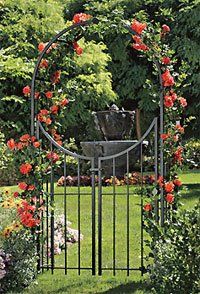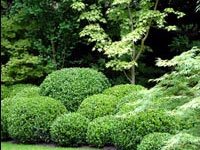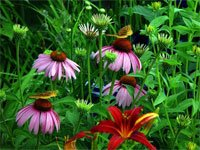The Beauty Of Iron Arbors
Saturday, September 23, 2006 A metal arbor can be used as a focal point for any garden. They can be constructed from almost any malleable metal, but the most common ones are wrought iron arbors. The intricacy of the wrought ironwork can be extremely simple, or incredibly complex. There really is one to suit any taste and pocket.
A metal arbor can be used as a focal point for any garden. They can be constructed from almost any malleable metal, but the most common ones are wrought iron arbors. The intricacy of the wrought ironwork can be extremely simple, or incredibly complex. There really is one to suit any taste and pocket. The majority of metal arbors are used to encourage climbing plants to form a shaded area. Many people install an iron arbor and plant climbing rose bushes all around the closed areas to form a wonderfully fragrant and shaded seating area. A metal arbor traditionally has only one open side, unlike a pergola or archway. That is why it is more suited for use as a shaded seating area.
Iron arbors, or any type of metal arbor, are extremely heavy constructions. They are usually set in concrete and are seldom repositioned. It is not very practical to set a metal arbor on soft ground or grass. The wrought iron arbor is likely to sink into the surface. For the same reason, metal arbors are not often moved. There is a lot of effort required in changing the position of an established iron arbor so it is worth planning its location carefully.
The variety of styles and sizes of metal arbors that are available means that the prices vary dramatically, too. The cheapest ones are under $100, but there is no limit to how much the most expensive might be. Many wrought iron arbors are handcrafted, which adds to the cost, but ensures that it is unlike any other metal arbor. The length of time that a commissioned iron arbor will take to finish also varies with the intricacy of the metalwork involved.
Caring for an iron arbor really depends on personal preference. If you want your metal arbor to be gleaming and new for life, it will need rust treatments and repainting when appropriate. However, many owners of metal arbors prefer to leave it to the elements. This produces a lovely rusted antique look to the iron arbor. Of course, if you are encouraging climbing shrubs to cover the metal arbor then you will not be able to, or want to, perform any maintenance on the iron arbor itself. It is possible to buy iron arbors that have come from other gardens and have already acquired the weathered appearance, but these are few and far between.
Creating a metal arbor is not something that the average DIY enthusiast is likely to be able to do. The skills involved are metalwork and welding, at the very least. The most ornate of wrought iron arbors can only be produced by skilled metalworkers and craftsmen. The most beautiful metal arbors are those that have been in situ for a number of years and have fragrant roses entwined in their intricate ironwork. These iron arbors can give the owner a truly calming place of refuge from the hustle and bustle of today.











